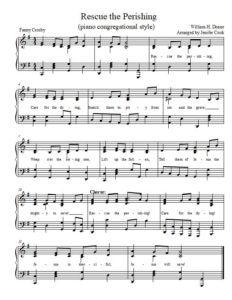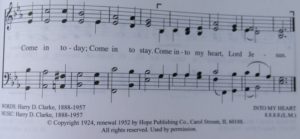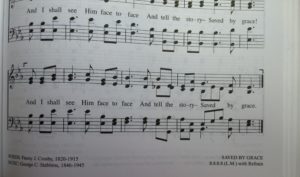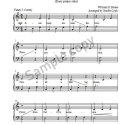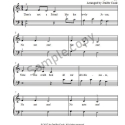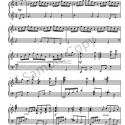Free Piano Arrangement! Rescue the Perishing
May 31st, 2019Just finished writing a quickie congregational arrangement for Rescue the Perishing.
My daughter in law is covering for me on the piano this Sunday and I just realized I didn’t have a congregational arrangement of this song written out….so squeaked this one out in about thirty minutes…not always that quick 😉
I want to publish another congregational booklet asap….just so much writing IS taking place…even though you haven’t seen the fruits of my labor yet! 😉
My husband reminds me…”quality” Jenifer not “quantity”. I can truthfully say that is taking place….hopefully!
Thanks for your extreme patience.
Click here to download your free copy of “Rescue the Perishing” congregational accompaniment
Current Project: Left Hand Patterns for Congregational Accompaniment
May 30th, 2019Wow! I already have a list of at least twelve different left hand patterns for hymns with busy melodies in 4/4 time!
Can’t wait to complete this first booklet of ideas!
It’s a challenge for me to focus on just one aspect while preparing instructive material because I come across so many other ideas closely related but don’t want to give you all info overload!
I’m jotting my random ideas down and saving them for another time.
I think the greatest challenge during the prep time is coming up with a simple, concise way to present the concept.
Here’s an example of how I may display the left hand patterns on the master content list. (There will be PLENTY of visual examples to accompany these ideas)
- octave-chord-octave-chord (all quarter notes)
- octave-chord-octave-octave (all quarter notes)
- octave-chord-octave-quarter-rest (three quarter notes plus one quarter rest)
As of now….I plan to number the visual examples with the number that corresponds to the numbered list of patterns on the master content list.
There are SO many variables to this topic. I will have to discuss right hand activity as well since the left hand is affected by what the right hand plays.
For example: It’s easier on the pianist (truly!) to omit notes here and there during a busy melody and focus more on the main beats. The singers can fill in the missing notes 😉 The key is… omitting melody in places that don’t throw off the singers.
Simple: Start by playing melody at the beginning of the song and then omit a note here and there once you get them going 😉
More on that topic in my first booklet.
Met My First Reader in Person!
May 18th, 2019My husband told me this day would come 🙂
One of my website readers approached me in a parking lot this past weekend… and said,”Are you the church pianist!?”
I told her it was a first for me to have a total stranger recognize me out and about in the middle of nowhere!
I asked for a picture with her 🙂
Thanks to all of you like this lady…who encourage me to keep writing!
Peppy Hymns for Piano Arrangements
May 15th, 2019Update: Just to let you know: I’m working on a moderate advanced piano solo for “The Old Account Was Settled Long Ago”
You can still leave peppy hymn suggestions below 🙂 Thanks!
One of my readers requested more piano solo arrangements of the old traditional peppy hymns. A great suggestion!
So…I thought I would ask my readers for some peppy hymn suggestions.
Our niche is the traditional hymns in the public domain.
Examples: When I See the Blood, Showers of Blessing
The hymn is copyrighted if it has a copyright label at the bottom or top of the hymn similar to this:
The hymn is public domain if there isn’t a copyright label at the bottom or top of the hymn similar to this:
New Beginner Sacred Piano Solos!
May 15th, 2019Just to alert my beginner church pianists…I published two beginner sacred piano solos this week.
The titles: Near the Cross and No Not One. I wrote these pieces for my students. My younger students have really enjoyed playing No Not One. The older beginner students like Near the Cross.
Both pieces contain suggested fingering for the beginner to late beginner student.
Piano Tip: Rushed vs. Non-rushed!
May 3rd, 2019I think we’ve all been guilty of rushing busy passages in piano arrangements. The brain computes…”lots of notes….I must go fast!”
When in reality, a lot of these passages are meant to be handled a bit slower than what appears on the page.
Take time to “feel” the music…breathing life into the piece!
Left Hand Pattern for Hymn Playing
April 12th, 2019One of my readers recently asked for ideas on left hand octave chord patterns. This is just one of many patterns possible!
I started with a fairly easy one and will share another pattern when able. Sorry for this quick-thrown-together video due to time restraints.
I’m preparing to help out my Mom after she has same day surgery on her knee. Much going on but I will try to at least share quick tips or such for at least the next month…then maybe the dust will settle by then ;).
Improvising Hymns: First Booklet in the Works!
March 29th, 2019I want to create a series of booklets on hymn improvising ideas for the church pianist.
The first booklet is going to deal with left hand patterns for devotional style hymns. (I’m working on it now)
The most challenging part for me is presenting everything in a well ordered approach.
I want to keep these books practical, short and concise. Each booklet will deal with one topic.
Another booklet will deal with right hand fill-ins and so on. Hopefully the church pianist can grasp the concept(s) from each booklet in order to make application on their own.
Each booklet will provide a sufficient amount of examples for ample reinforcement.
The booklets will be geared to the intermediate and beyond church pianist.
The church pianist will need to know their scales, chords and chord inversions. A prior knowledge of interval reading would also be helpful.
For the first booklet, the concepts and examples will be presented in the keys of C , F, and G Major for ease of application.
I’m considering naming the booklet series “Making Hymns Expressive”.
New Sacred Piano Solo: There is a Fountain
March 26th, 2019I loved writing this arrangement because I wrote how I felt like expressing it at the time. When I try to structure my pieces…it sometimes stifles my creativity.
But….structure is also good because it makes the piece more playable…without awkward leaps and such.
I have SO many favorite hymns and “There is a Fountain” is on that list!
I tried to depict an overflowing fountain in the beginning and ended with a different twist…still sounding as a fountain.
This piece is geared to the early to moderately advanced church pianist. The entire arrangement stays in the key of C but contains a lot of full chords.

